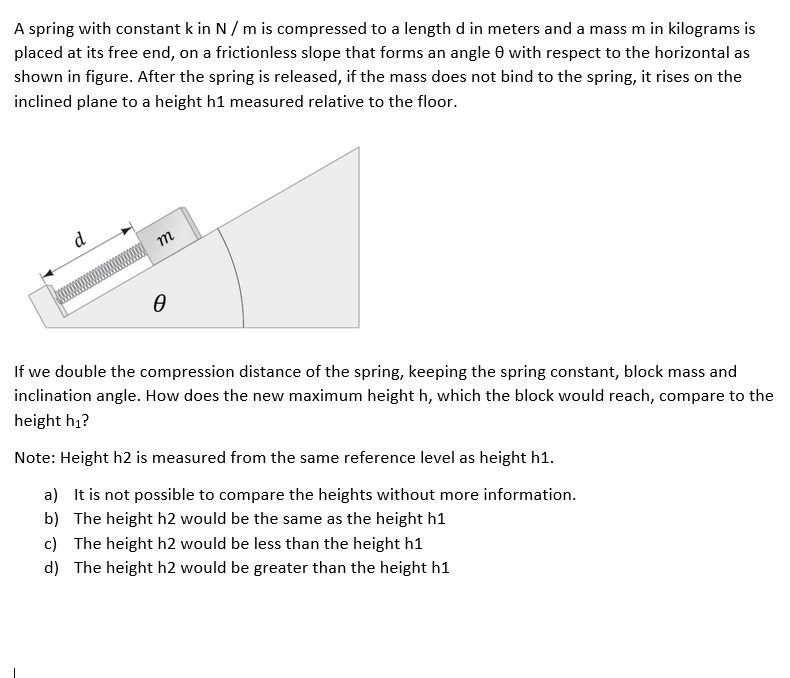A spring with constant k in N / m is compressed to a length d in meters and a mass m in kilograms is placed at its free end, on a frictionless slope that forms an angle 0 with respect to the horizontal as shown in figure. After the spring is released, if the mass does not bind to the spring, it rises on the inclined plane to a height h1 measured relative to the floor. d т If we double the compression distance of the spring, keeping the spring constant, block mass and inclination angle. How does the new maximum height h, which the block would reach, compare to the height h1? Note: Height h2 is measured from the same reference level as height h1. a) It is not possible to compare the heights without more information. b) The beight h2 would be the same as the height h1
A spring with constant k in N / m is compressed to a length d in meters and a mass m in kilograms is placed at its free end, on a frictionless slope that forms an angle 0 with respect to the horizontal as shown in figure. After the spring is released, if the mass does not bind to the spring, it rises on the inclined plane to a height h1 measured relative to the floor. d т If we double the compression distance of the spring, keeping the spring constant, block mass and inclination angle. How does the new maximum height h, which the block would reach, compare to the height h1? Note: Height h2 is measured from the same reference level as height h1. a) It is not possible to compare the heights without more information. b) The beight h2 would be the same as the height h1
University Physics Volume 1
18th Edition
ISBN:9781938168277
Author:William Moebs, Samuel J. Ling, Jeff Sanny
Publisher:William Moebs, Samuel J. Ling, Jeff Sanny
Chapter7: Work And Kinetic Energy
Section: Chapter Questions
Problem 108CP: Consider a linear spring, as in Figure 7.7(a), with mass M uniformly distributed along its length....
Related questions
Question

Transcribed Image Text:A spring with constant k in N / m is compressed to a length d in meters and a mass m in kilograms is
placed at its free end, on a frictionless slope that forms an angle 0 with respect to the horizontal as
shown in figure. After the spring is released, if the mass does not bind to the spring, it rises on the
inclined plane to a height h1 measured relative to the floor.
d
m
If we double the compression distance of the spring, keeping the spring constant, block mass and
inclination angle. How does the new maximum height h, which the block would reach, compare to the
height h1?
Note: Height h2 is measured from the same reference level as height h1.
a) It is not possible to compare the heights without more information.
b) The height h2 would be the same as the height h1
c) The height h2 would be less than the height h1
d) The height h2 would be greater than the height h1
Expert Solution
This question has been solved!
Explore an expertly crafted, step-by-step solution for a thorough understanding of key concepts.
Step by step
Solved in 2 steps

Knowledge Booster
Learn more about
Need a deep-dive on the concept behind this application? Look no further. Learn more about this topic, physics and related others by exploring similar questions and additional content below.Recommended textbooks for you

University Physics Volume 1
Physics
ISBN:
9781938168277
Author:
William Moebs, Samuel J. Ling, Jeff Sanny
Publisher:
OpenStax - Rice University

Classical Dynamics of Particles and Systems
Physics
ISBN:
9780534408961
Author:
Stephen T. Thornton, Jerry B. Marion
Publisher:
Cengage Learning

Principles of Physics: A Calculus-Based Text
Physics
ISBN:
9781133104261
Author:
Raymond A. Serway, John W. Jewett
Publisher:
Cengage Learning

University Physics Volume 1
Physics
ISBN:
9781938168277
Author:
William Moebs, Samuel J. Ling, Jeff Sanny
Publisher:
OpenStax - Rice University

Classical Dynamics of Particles and Systems
Physics
ISBN:
9780534408961
Author:
Stephen T. Thornton, Jerry B. Marion
Publisher:
Cengage Learning

Principles of Physics: A Calculus-Based Text
Physics
ISBN:
9781133104261
Author:
Raymond A. Serway, John W. Jewett
Publisher:
Cengage Learning

Physics for Scientists and Engineers, Technology …
Physics
ISBN:
9781305116399
Author:
Raymond A. Serway, John W. Jewett
Publisher:
Cengage Learning